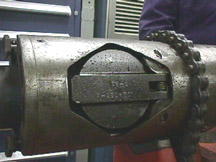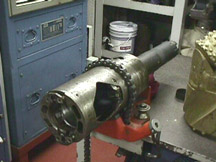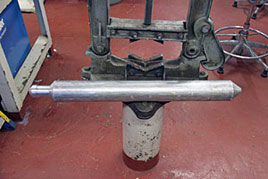Lockable Flapper Valve and Go-Devil
The lockable flapper valve (LFV) is a component of the APC/XCB Bottom Hole Assembly (BHA). It is hinged and sprung on one side and is designed to prevent fluids from backflowing up the drill pipe.
The LFV presents an obstacle for the logging operation, as a closed LFV could snag a tool string as it is withdrawn from the open hole into pipe. The LFV is engineered to pass tools through a diameter of 3.625 in (9.2 cm), but to lock open or release with the passage of a 3.75 in (9.5 cm) tool. For this reason a go-devil (an attachment at the end of the tool string) is deployed to open the valve as the tool passes through downward. As the tool is withdrawn to the surface, the go-devil again closes the LFV. Certain tools can work as a go-devil because their diameter is very close to 3.75 in (9.5 cm). When the RCB BHA is used, the LFV is not an issue. In RCB logging operations the bit is released either in the hole or on the seafloor, or is removed at the surface so logging tools pass through pipe with no other obstructions.
There are two methods for running the go-devil:
1. The go-devil is attached to the bottom of each tool string, and the LFV is opened and closed for each logging run. The disadvantage of this is that it sometimes takes a few attempts to get the go-devil through the LFV.
2. The go-devil is pumped down on its own before logging, and the LFV stays open for all logging runs until by a tool with a diameter of 3.75 in (9.5 cm). The disadvantage of pumping a go-devil here is that the hole cannot be deepened, because the go-devil will be sitting at the bottom of the hole.



